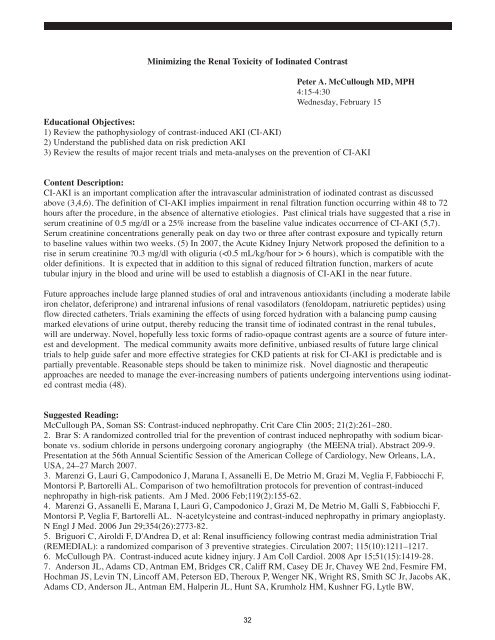ABSTRACTS from 16th International COnference on ... - CRRT Online
ABSTRACTS from 16th International COnference on ... - CRRT Online
ABSTRACTS from 16th International COnference on ... - CRRT Online
You also want an ePaper? Increase the reach of your titles
YUMPU automatically turns print PDFs into web optimized ePapers that Google loves.
Minimizing the Renal Toxicity of Iodinated C<strong>on</strong>trast<br />
Peter A. McCullough MD, MPH<br />
4:15-4:30<br />
Wednesday, February 15<br />
Educati<strong>on</strong>al Objectives:<br />
1) Review the pathophysiology of c<strong>on</strong>trast-induced AKI (CI-AKI)<br />
2) Understand the published data <strong>on</strong> risk predicti<strong>on</strong> AKI<br />
3) Review the results of major recent trials and meta-analyses <strong>on</strong> the preventi<strong>on</strong> of CI-AKI<br />
C<strong>on</strong>tent Descripti<strong>on</strong>:<br />
CI-AKI is an important complicati<strong>on</strong> after the intravascular administrati<strong>on</strong> of iodinated c<strong>on</strong>trast as discussed<br />
above (3,4,6). The definiti<strong>on</strong> of CI-AKI implies impairment in renal filtrati<strong>on</strong> functi<strong>on</strong> occurring within 48 to 72<br />
hours after the procedure, in the absence of alternative etiologies. Past clinical trials have suggested that a rise in<br />
serum creatinine of 0.5 mg/dl or a 25% increase <str<strong>on</strong>g>from</str<strong>on</strong>g> the baseline value indicates occurrence of CI-AKI (5,7).<br />
Serum creatinine c<strong>on</strong>centrati<strong>on</strong>s generally peak <strong>on</strong> day two or three after c<strong>on</strong>trast exposure and typically return<br />
to baseline values within two weeks. (5) In 2007, the Acute Kidney Injury Network proposed the definiti<strong>on</strong> to a<br />
rise in serum creatinine ?0.3 mg/dl with oliguria ( 6 hours), which is compatible with the<br />
older definiti<strong>on</strong>s. It is expected that in additi<strong>on</strong> to this signal of reduced filtrati<strong>on</strong> functi<strong>on</strong>, markers of acute<br />
tubular injury in the blood and urine will be used to establish a diagnosis of CI-AKI in the near future.<br />
Future approaches include large planned studies of oral and intravenous antioxidants (including a moderate labile<br />
ir<strong>on</strong> chelator, deferipr<strong>on</strong>e) and intrarenal infusi<strong>on</strong>s of renal vasodilators (fenoldopam, natriuretic peptides) using<br />
flow directed catheters. Trials examining the effects of using forced hydrati<strong>on</strong> with a balancing pump causing<br />
marked elevati<strong>on</strong>s of urine output, thereby reducing the transit time of iodinated c<strong>on</strong>trast in the renal tubules,<br />
will are underway. Novel, hopefully less toxic forms of radio-opaque c<strong>on</strong>trast agents are a source of future interest<br />
and development. The medical community awaits more definitive, unbiased results of future large clinical<br />
trials to help guide safer and more effective strategies for CKD patients at risk for CI-AKI is predictable and is<br />
partially preventable. Reas<strong>on</strong>able steps should be taken to minimize risk. Novel diagnostic and therapeutic<br />
approaches are needed to manage the ever-increasing numbers of patients undergoing interventi<strong>on</strong>s using iodinated<br />
c<strong>on</strong>trast media (48).<br />
Suggested Reading:<br />
McCullough PA, Soman SS: C<strong>on</strong>trast-induced nephropathy. Crit Care Clin 2005; 21(2):261–280.<br />
2. Brar S: A randomized c<strong>on</strong>trolled trial for the preventi<strong>on</strong> of c<strong>on</strong>trast induced nephropathy with sodium bicarb<strong>on</strong>ate<br />
vs. sodium chloride in pers<strong>on</strong>s undergoing cor<strong>on</strong>ary angiography (the MEENA trial). Abstract 209-9.<br />
Presentati<strong>on</strong> at the 56th Annual Scientific Sessi<strong>on</strong> of the American College of Cardiology, New Orleans, LA,<br />
USA, 24–27 March 2007.<br />
3. Marenzi G, Lauri G, Campod<strong>on</strong>ico J, Marana I, Assanelli E, De Metrio M, Grazi M, Veglia F, Fabbiocchi F,<br />
M<strong>on</strong>torsi P, Bartorelli AL. Comparis<strong>on</strong> of two hemofiltrati<strong>on</strong> protocols for preventi<strong>on</strong> of c<strong>on</strong>trast-induced<br />
nephropathy in high-risk patients. Am J Med. 2006 Feb;119(2):155-62.<br />
4. Marenzi G, Assanelli E, Marana I, Lauri G, Campod<strong>on</strong>ico J, Grazi M, De Metrio M, Galli S, Fabbiocchi F,<br />
M<strong>on</strong>torsi P, Veglia F, Bartorelli AL. N-acetylcysteine and c<strong>on</strong>trast-induced nephropathy in primary angioplasty.<br />
N Engl J Med. 2006 Jun 29;354(26):2773-82.<br />
5. Briguori C, Airoldi F, D'Andrea D, et al: Renal insufficiency following c<strong>on</strong>trast media administrati<strong>on</strong> Trial<br />
(REMEDIAL): a randomized comparis<strong>on</strong> of 3 preventive strategies. Circulati<strong>on</strong> 2007; 115(10):1211–1217.<br />
6. McCullough PA. C<strong>on</strong>trast-induced acute kidney injury. J Am Coll Cardiol. 2008 Apr 15;51(15):1419-28.<br />
7. Anders<strong>on</strong> JL, Adams CD, Antman EM, Bridges CR, Califf RM, Casey DE Jr, Chavey WE 2nd, Fesmire FM,<br />
Hochman JS, Levin TN, Lincoff AM, Peters<strong>on</strong> ED, Theroux P, Wenger NK, Wright RS, Smith SC Jr, Jacobs AK,<br />
Adams CD, Anders<strong>on</strong> JL, Antman EM, Halperin JL, Hunt SA, Krumholz HM, Kushner FG, Lytle BW,<br />
32
















